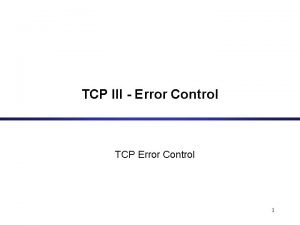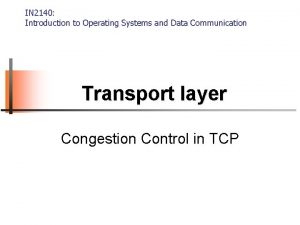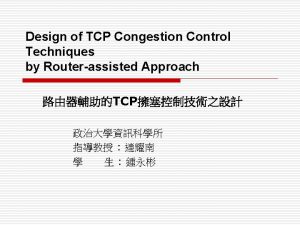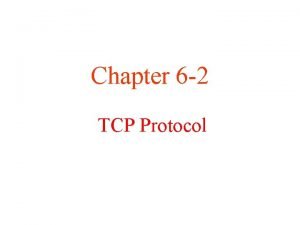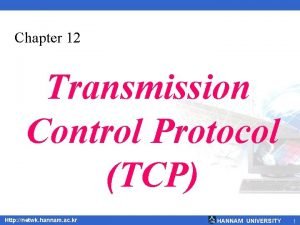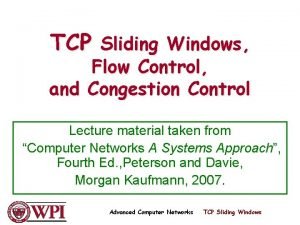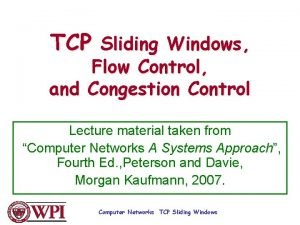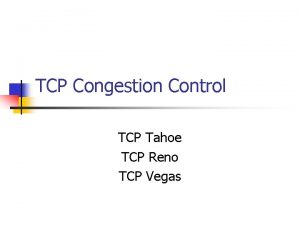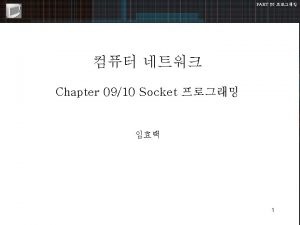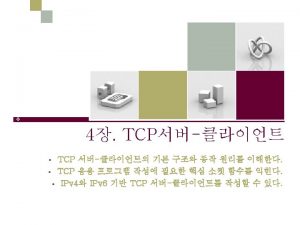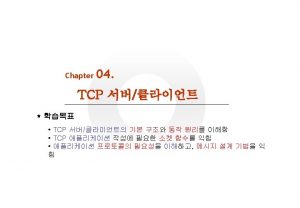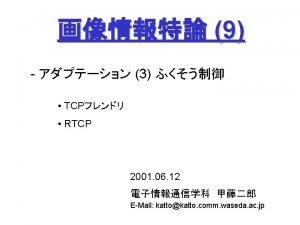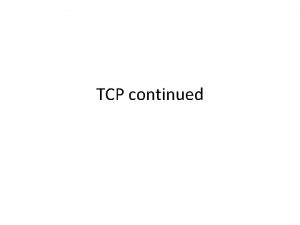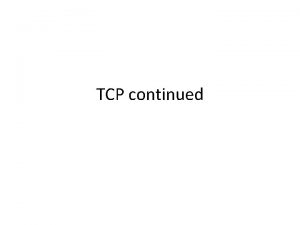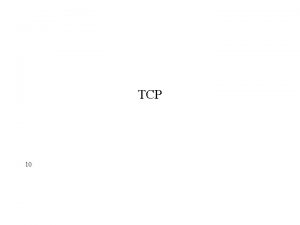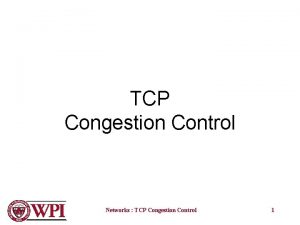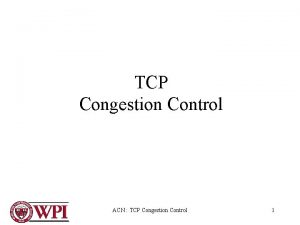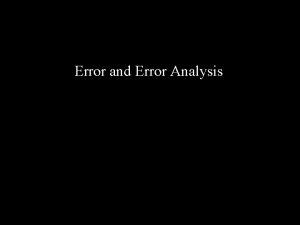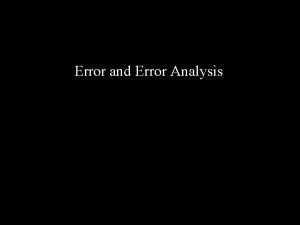TCP III Error Control TCP Error Control 1



















- Slides: 19

TCP III - Error Control TCP Error Control 1

ARQ Error Control • Two types of errors: – Lost packets – Damaged packets • Most Error Control techniques are based on: 1. Error Detection Scheme (Parity checks, CRC). 2. Retransmission Scheme. • Error control schemes that involve error detection and retransmission of lost or corrupted packets are referred to as Automatic Repeat Request (ARQ) error control. 2

Background: ARQ Error Control • The most common ARQ retransmission schemes: – Stop-and-Wait ARQ – Go-Back-N ARQ – Selective Repeat ARQ • The protocol for sending ACKs in all ARQ protocols are based on the sliding window flow control scheme • TCP uses a version of the Go-Back-N Protocol 3

Background: Go-Back-N ARQ • Go-Back-N sends cumulative acknowledgments Packets 2, 3, 4, 5 are retransmitted Timeout for Packet 2 A t Packe 4 5 2 t Packe 5 3 t Packe 4 t Packe 2 3 Packet 1 t Packe t 0 Packe ACK 5 ACK 6 ACK 4 3 ACK 1 ACK 2 ACK B 1 loss 4

Retransmissions in TCP • A TCP sender retransmits a segment when it assumes that the segment has been lost: 1. No ACK has been received and a timeout occurs 2. Multiple ACKs have been received for the same segment 5

Receiving duplicate ACKs • If three or more duplicate ACKs are received in a row, the TCP sender believes that a segment has been lost. • Then TCP performs a retransmission of what seems to be the missing segment, without waiting for a timeout to happen. • This can fix losses of single segments 6

Retransmission Timer • • TCP sender maintains one retransmission timer for each connection When the timer reaches the retransmission timeout (RTO) value, the sender retransmits the first segment that has not been acknowledged • The timer is started when 1. When a packet with payload is transmitted and timer is not running 2. When an ACK arrives that acknowledges new data, 3. When a segment is retransmitted • The timer is stopped when 1. All segments are acknowledged 7

How to set the timer • Retransmission Timer: – The setting of the retransmission timer is crucial for good performance of TCP – Timeout value too small results in unnecessary retransmissions – Timeout value too large long waiting time before a retransmission can be issued – A problem is that the delays in the network are not fixed – Therefore, the retransmission timers must be adaptive 8

Setting the value of RTO: • The RTO value is set based on round-trip time (RTT) measurements that each TCP performs • Each TCP connection measures the time difference between the transmission of a segment and the receipt of the corresponding ACK • There is only one measurement ongoing at any time (i. e. , measurements do not overlap) • Figure on the right shows three RTT measurements 9

Setting the RTO value • RTO is calculated based on the RTT measurements – Uses an exponential moving average to calculate estimators for delay (srtt) and variance of delay (rttvar) from • The RTT measurements are smoothed by the following estimators srtt and rttvar: srttn+1 = a RTT + (1 - a ) srttn rttvarn+1 = b ( | RTT - srttn | ) + (1 - b ) rttvarn RTOn+1 = srttn+1 + 4 rttvarn+1 – The gains are set to a =1/4 and b =1/8 10

Setting the RTO value (cont’d) • Initial value for RTO: – Sender should set the initial value of RTO to RTO 0 = 3 seconds • RTO calculation after first RTT measurements arrived srtt 1 = RTT rttvar 1 = RTT / 2 RTO 1 = srtt 1 + 4 rttvarn+1 • When a timeout occurs, the RTO value is doubled RTOn+1 = max ( 2 RTOn, 64) seconds This is called an exponential backoff 11

Karn’s Algorithm If an ACK for a retransmitted segment is received, the sender cannot tell if the ACK belongs to the original or the retransmission. RTT measurements is ambiguous in this case Karn’s Algorithm: • Don’t update RTT on any segments that have been retransmitted • Restart RTT measurements only after an ACK is received for a segment that is not retransmitted 12

RTO Calculation: Example 13

TCP Retransmission Timer • Retransmission Timer: – The setting of the retransmission timer is crucial for efficiency – Timeout value too small results in unnecessary retransmissions – Timeout value too large long waiting time before a retransmission can be issued – A problem is that the delays in the network are not fixed – Therefore, the retransmission timers must be adaptive 14

Round-Trip Time Measurements • The retransmission mechanism of TCP is adaptive • The retransmission timers are set based on round-trip time (RTT) measurements that TCP performs The RTT is based on time difference between segment transmission and ACK But: TCP does not ACK each segment Each connection has only one timer 15

Round-Trip Time Measurements • Retransmission timer is set to a Retransmission Timeout (RTO) value. • RTO is calculated based on the RTT measurements. • The RTT measurements are smoothed by the following estimators srtt and rttvar: srttn+1 = a RTT + (1 - a ) srttn rttvarn+1 = b ( | RTT - srttn+1 | ) + (1 - b ) rttvarn RTOn+1 = srttn+1 + 4 rttvarn+1 • The gains are set to a =1/4 and b =1/8 • srtt 0 = 0 sec, rttvar 0 = 3 sec, Also: RTO 1 = srtt 1 + 2 rttvar 1 16

Karn’s Algorithm • If an ACK for a retransmitted segment is received, the sender cannot tell if the ACK belongs to the original or the retransmission. Karn’s Algorithm: Don’t update srtt on any segments that have been retransmitted. Each time when TCP retransmits, it sets: RTOn+1 = max ( 2 RTOn, 64) (exponential backoff) 17

Measuring TCP Retransmission Timers • Transfer file from Argon to neonn • Unplug Ethernet of Argon cable in the middle of file transfer 18

Interpreting the Measurements • The interval between retransmission attempts in seconds is: 1. 03, 3, 6, 12, 24, 48, 64, 64, 64, 64. • Time between retransmissions is doubled each time (Exponential Backoff Algorithm) • Timer is not increased beyond 64 seconds • TCP gives up after 13 th attempt and 9 minutes. 19
 Tcp iii
Tcp iii Error control in tcp
Error control in tcp Hamlet act iii scene ii
Hamlet act iii scene ii Jelaskan tentang error control pada data link control?
Jelaskan tentang error control pada data link control? Flow control and error control
Flow control and error control Tcp congestion control
Tcp congestion control Tcp congestion control
Tcp congestion control Tcp flow control
Tcp flow control Cpe426
Cpe426 New reno tcp
New reno tcp Tcp segment header size
Tcp segment header size Tcp
Tcp Tcp flow control diagram
Tcp flow control diagram Tcp (transmission control protocol) to protokół
Tcp (transmission control protocol) to protokół Tcp flow control sliding window
Tcp flow control sliding window Tcp flow control sliding window
Tcp flow control sliding window Tcp sliding window
Tcp sliding window Type 1 error vs type 2 error example
Type 1 error vs type 2 error example Type 1 error vs type 2 error example
Type 1 error vs type 2 error example Gyro error examples
Gyro error examples
